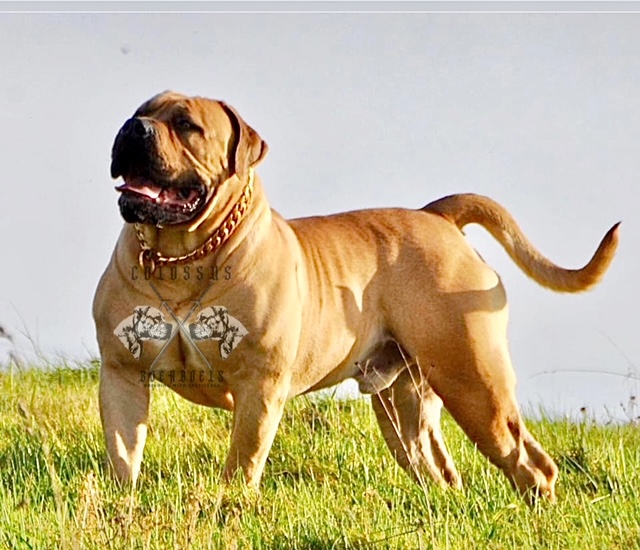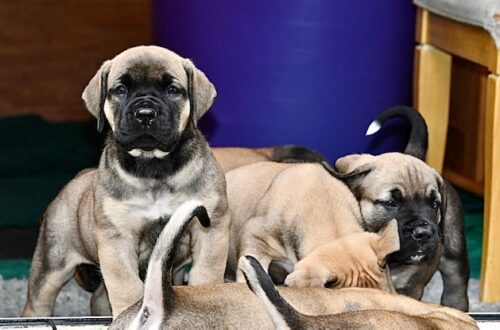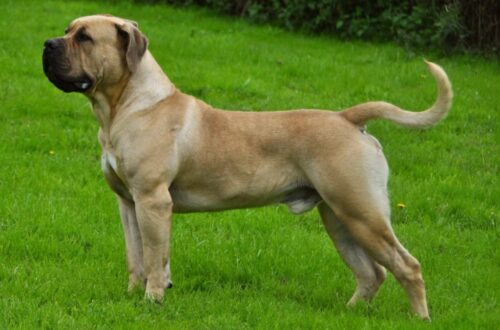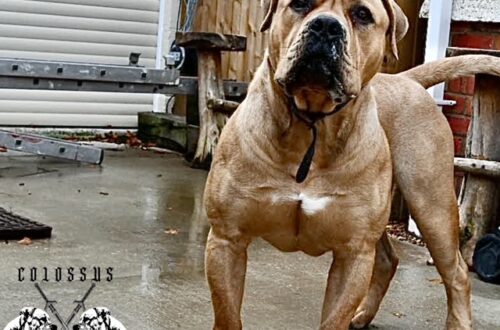
SABBS – Boerboel History
History of the Boerboel
Written by Anemari Pretorius
Someone once told me that they had read in some dictionary or other that the boel part of the name Boerboel means a lot of dog. I was unfortunately unable to trace this particular definition, but if I were to create my own dictionary I am almost positive that this would be my description as well, only more so. According to the 1987 edition of the Verklarende Handwoordeboek van die Afrikaanse taal the meaning of the word Boerboel is given as a farm dog of uncertain origin. This is most certainly no longer true, as I am sure you will acknowledge once you have read through this chapter.
According to information portrayed in the Syrian rooms of the renowned British Museum in London, two Assyrian kings, Asarhaddon and Ashurbani-pal, were already using large dogs to hunt wild horses and lions in the 7th century before the coming of Christ. The stories depicted by these murals in the museum’s displays show that the Syrian dogs were much bigger and heavier than the dog breeds we are familiar with today. The author, Darwin, also makes mention of a large dog being shown on the grave of King Asarhaddon’s son, which dates back to the year 640 BC.
In one of Philemon Holland’s works, translated from Pliny’s Natural History, 1601, there are several references to prominent persons who used large dogs for various purposes. For instance, a Germanic king who returned from exile used 200 dogges to reconquer his dominion. Reference is also made to the Cimbrians who used dogges to guard their belongings whilst they where engaged in bloody battles.
In the same document reference is also made to the King of Albania giving Alexander the Great the gift of a dog. Alexander was very impressed with this giant animal, until he tried to use it to hunt bears, wild boar and deer – the dog did not show the least bit of interest or inclination to participate in any way. Alexander the Great, mighty king and conqueror, was livid at the dog’s “laziness” and subsequently had it destroyed. On hearing this news, the King of Albania immediately sent a replacement dog to Alexander with the instruction: “Do not waste the dog’s time with minor things.
Give him a lion or an elephant to fight.”
The story goes that Alexander first pitted the dog against a lion, and the lion’s back was broken within seconds of the fight starting. An elephant was next. In a panic it tried to evade the dog’s continuous attacks and ended up falling to its death down an embankment.
Other narratives of dogs killing lions are to be found in the writings of Megasthenes, Aelien, Diodorus, Siculus, Strabo and Plutarch. A monk in the service of King Louis IX of France describes (in his Travels of William de Rubruquis) how enormous the dogs of Albania were – large enough to fight against lions and bulls, and even large enough to be harnessed like oxen in front of wagons. These dogs of Syria and Albania were eventually introduced as far afield as modern Europe, the Far- and Middle East and the British Isles.
Various documents explain the origins of today’s modern breeds from these ancient dogs – from a time well before the coming of Christ. The Canis Molossus (during the time of the Roman Empire) played an important part in the derivation of modern large breeds. The activities of the Romans resulted in the importation of these dogs to the British Isles. However, there are major differences of opinion about the order of events. Some authors are of the opinion that the Romans took this Canis Molossus to the British Isles, whilst others maintain that the Romans took some English dogs back with them to Europe. Both these claims could well be valid.
Various documents also report on trade that took place between the East and the West and, of course, the British Isles. In time, our very own Cape of Good Hope inevitably became a very important sea route for trade purposes.
The Verenigde Oost-Indische Compagnie (Dutch East India Company) sent Jan van Riebeeck to establish a trading post at the southern tip of Africa. On arrival in the Cape in 1652, his trusty Bullenbijter was at his side. This was a big, strong Mastiff- type breed. (Strangely enough, the bilingual dictionary of Bosman, Van der Merwe and Hiemstra, 1999, indicates that the term Mastiff means, amongst other things, Boerboel and bul(le)byter – biter of bulls.)
The colonists that followed Van Riebeeck to the Cape also brought their biggest and strongest dogs with them, and over time only the toughest of these survived this new, harsh and rugged land of ours.
With the arrival of the British Settlers in 1820, the Bulldog and another Mastiff-type dog were also introduced, amongst many others. It should be noted that the true Bull Mastiff was only imported to South Africa in 1928, by De Beers, to be guard dogs on the diamond mines. It is told that after the Anglo-Boer War in 1902, these various dog breeds were crossbred with the English long-legged Bulldog, and subsequently also with the Bull Mastiff in the late 1940’s and early 1950’s.
At this point in the history of the Boerboel breed, most people would like to end the story because part of the further history includes the crossbreeding of the colonists’ large dogs with the dogs (mongrels) of the black inhabitants of Africa. But, truth be told, this is how the Boerboel, as found on countless farms and which later trekked north with the Great Trek, originated.
There is, however, also some interesting information available that gives rise to alternative viewpoints regarding the Boerboel’s origins. A well-known writer, E.C. Ash, claims that there is evidence of massive dogs with Mastiff-like appearance that existed during ancient Egyptian times. Ash maintains that one illustration dates as far back as 2000 BC. During the time of Kings Saul, David and Solomon, Tirus was King of Phoenicia. At this stage, a very busy trade existed between, amongst others, Syria, Persia and King Solomon.
All these snippets of information seem not to mean much – until one reads the following … the King of Persia, Artaxerxes Memnon, had a private doctor in his court who was very well read and well travelled. This doctor wrote that a barbaric tribe in the south of Ethiopia (known as the Cynomones) had dogs described as Indian dogs, which were descendants of the Babylonian dog. These dogs were considered a tradeable commodity and were described as big and strong – the size of Hyrcanians and suitable for fighting lions. Pliny’s Natural History also refers to them, but confuses them with Cynocephali.
The Cynomones bred large numbers of these dogs to use for hunting, as well as to act as a means of diverting the hordes of wildebeest that would often destroy the tribe’s simple shelters and other possessions in their passage and stampedes during the late-summer migrations. The Cynomones also used to milk their bitches, just like other tribes milked their cattle and goats – hence the name Cynomolgi (dog milkers). This information is supported by writings of Diodorus, Siculus, Aelian and Polydeuktes.
Aristotle also wrote some fascinating things about this Indian dog. He said they were a cross between a dog and a tiger, and man could only start using the third generation of this crossbreed because earlier generations were too aggressive. When on heat, bitches were tied up in remote places, but many of them were eaten if the tigers did not feel like covering the females. It is noteworthy that Pliny repeats this selfsame information.
Today, of course, we believe that it is impossible to cross a dog with a tiger. According to Aristotle, the breeders of these dogs made the most of such stories for “advertising and marketing” purposes.
Nevertheless the Indian dog was grey or brindle. Makes one think, doesn’t it?
Further proof of the Indian dog can be found in documents stemming from the time of the then King of Persia, Darius Hystaspes, who relieved four hamlets in his kingdom of all other work so that they could exclusively care for (and gather food for) his dogs.
Thus the European connection of Jan van Riebeeck with his Bullenbijter now no longer seems to be the only (or most likely) source of origin of the Boerboel – especially if we go back to the mongrels mentioned earlier.
In time, various black African tribes moved south when they came into contact with the Europeans – naturally their dogs moved with them. A question that arises is whether the “African” dog with the distinctive V-shape on the tail is a descendant of the dogs of Ethiopia. If so, the value of this connection could have far-reaching implications on our current level of knowledge and understanding of the make-up of the Boerboel breed.
It could therefore be said that the Boerboel was bred from two main sources of genetic material, i.e.
- the Bullenbijter from Europe, with its early roots in Albania and Syria; and
- the African dog of the black tribes of Africa.
The African dog probably descended from the Cynomones of Ethiopia, with its earlier roots in Babylon during the Persian domination, and the even earlier lineages via India back to Albania and Syria. This may also explain why the Boerboel is structurally superior to all other Mastiff-type dogs. The genetic material that came together again in Africa has more pure, original Syrian bloodlines than any other breed in the world.
During the period between the arrival of Jan van Riebeeck and the Great Trek (1652 – 1838) the original Bullenbijter bloodline and those of other dogs belonging to the colonists were naturally more isolated than after the start of the Great Trek in 1838.
It is fascinating to research present bloodlines back to the turn of the century or even earlier. In this way one can ascertain where certain of the old bloodlines came from, and in some instances these can even be traced back to specific groups of trekkers who went north from the Cape.
By putting all of this information together one can come to the following clear conclusion: the Boerboel has been bred from large and strong dogs with good characteristics. One can become almost lyrical about these characteristics. Our forefathers kept Boerboels as watchdogs, as friends and playmates to their children, and as protectors – a dog that would not retreat from any form of danger.



